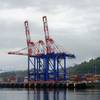The Exhaust Gas Cleaning Systems Association (EGCSA) has raised concerns regarding the possible delay to the adoption of a global limit on fuel oil sulphur emissions, which is to be considered by the International Maritime Organization (IMO) in October 2016.
The international association, which represents more than 25 member companies dedicated to reducing sulphur oxides (SOx) and particulate emissions from marine exhaust gas, says there is a need for action to prevent SOx emissions from continuing to cause health problems and damage to the environment, and stress that the technology to achieve SOx emissions equal to or even below the regulation limits is already proven, cost effective, and widely available.
MARPOL Annex VI, Regulation 14 stipulates that a global sulphur limit on fuel of 0.50 percentm/ should be used on board all ships as of January 1, 2020, except in Emission Control Areas (ECAs), where the existing limit is already 0.10 percent sulphur. There are, however, parties who would like to delay introduction of the new global limits until January 1, 2025.
“We cannot afford to ignore air quality issues for five more years,” said EGCSA director Don Gregory, speaking on behalf of the association’s members. “In 2016, we have a much clearer view of the 2020 economy than we do of the 2025 economy. To push back the global sulphur cap implementation date in order to reduce uncertainty in the marine industry would be a fallacy. A delayed global sulphur limit will not only continue to drive uncertainty, but it will kill today’s innovation and investments in developing emission reduction technology, will hinder research into alternative fuels, and will result in higher costs.
“The exhaust gas cleaning industry is ready for the new, tighter emissions regulations,” Gregory continued. “Together with installers, we have systems in place that will help ship owners easily and cost-effectively meet the 2020 requirements. Postponing the regulations will only prolong air quality problems. That is of no benefit to anyone and is frustrating for ship owners who currently do not know how to plan for the future.”
Over the coming five years, EGCSA members can outfit vessels with thousands of new scrubbers in time for the introduction of the 2020 global emissions limit. A survey conducted by the EGCSA in April 2016 indicated that capacity for manufacture and installation of marine scrubbers is likely to be almost 20 times as high at the end of 2019 as it was in 2015.
The EGCSA has provided industry insights at the request of IMO appointed consultants, CE Delft, and to those appointed by an oil and shipping association, Navigistics, who will both report on the projected availability of 0.50 percent S marine fuel on January 1, 2020. EGCSA members contributed data and research material to these marine scrubber capability and capacity studies to ensure the reports were robust and accurate.
The options available to shipowners facing fuel sulphur limitations are limited. Shipowners can consume expensive, low-sulphur marine gas oil; they can use engines that can work with liquefied natural gas (LNG); or they can install a scrubber and continue regular operations with heavy fuel oil. Since 2010, more than 600 vessels have made investments to allow them to meet low sulphur standards through LNG or exhaust gas cleaning technology. Early adoption of these alternatives reduces shipowners’ vulnerability to fuel market price volatility and will relieve demand on low sulphur fuels for the rest of the world, EGCSA said.
The regulations on sulphur reduction technologies have already been adopted and are well proven, according to EGCSA, who added that there is no uncertainty over SOx exhaust gas performance requirements. The only lack of clarity is around timing of the regulation. However, should SOx regulation enforcement be delayed as it was for the Ballast Water Convention, it will hurt early technology adopters, said EGCSA.
“In addition to the obvious damage to the environment and human health, a delay to the global limit will also result in a proliferation of patchwork regional sulphur limits: a more costly and more difficult compliance scenario for ship owners,” Gregory said. “If regulation is pushed back to 2025, it will result in a patchwork of local legislation as state authorities move to ensure they are seen to be responding to environmental concerns.”
According to EGCSA , certainty of the 2020 implementation date for sulphur emissions limits benefits all stakeholders. Increased adoption of alternative fuels, improved technology, improved air quality, confidence in investment, uniform global regulations, and sufficient time to plan and implement compliance strategies are just some of the beneficial outcomes.












